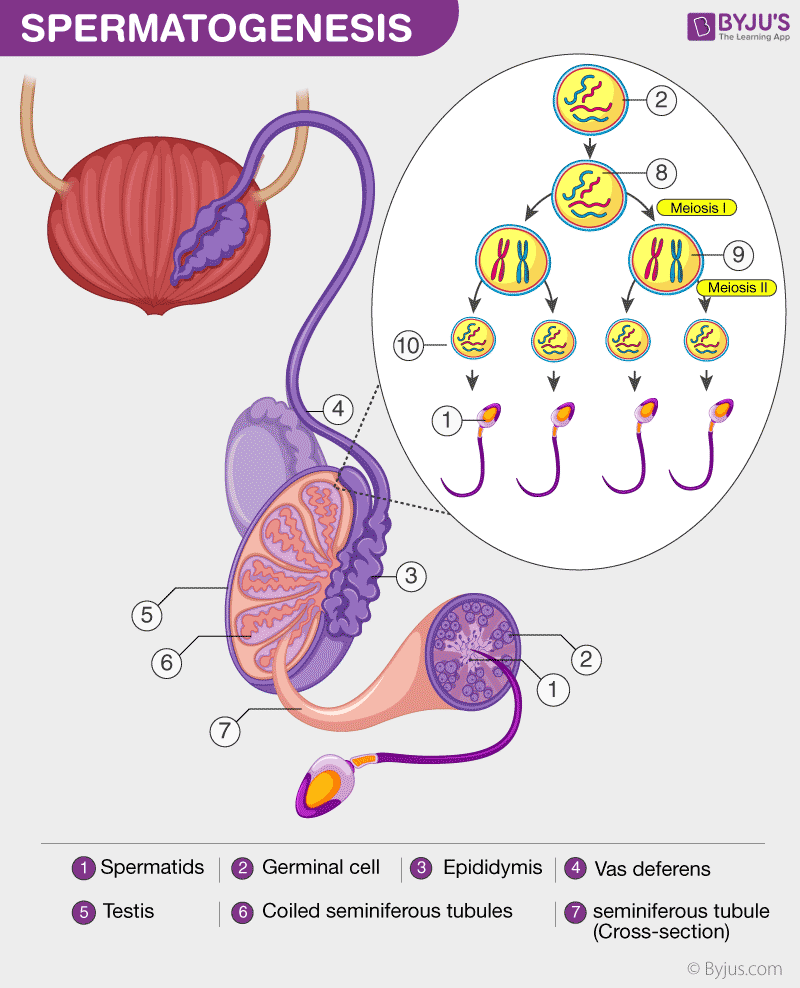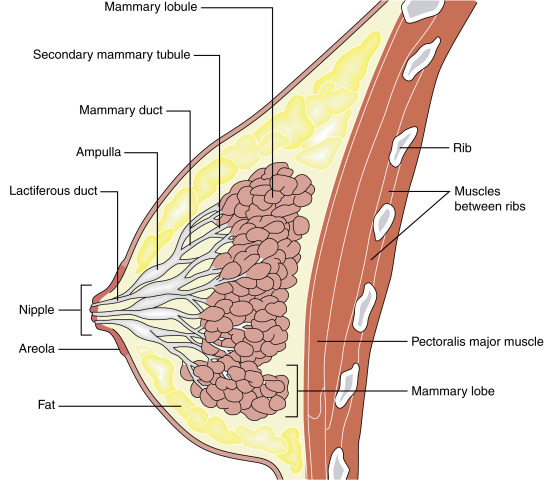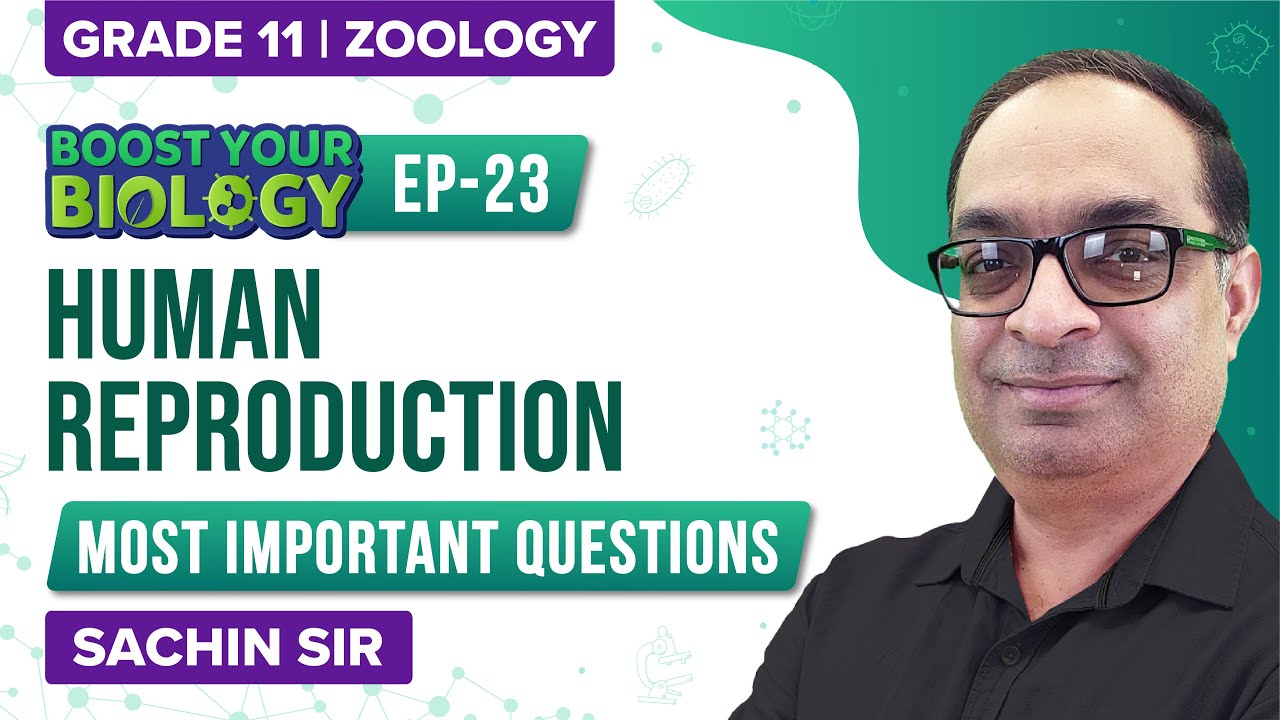Humans are sexually reproducing and viviparous in nature. The male and female reproductive systems undergo a series of events such as gametogenesis, insemination, fertilisation, and finally, embryo formation. Here is a collection of all the important questions that are important from the human reproduction chapter from Class 12 biology for NEET 2023 preparation.
- Which of the following statements is correct regarding primary sex organs?
(a) They are involved in gametogenesis.
(b) They are not involved in hormone production because they are not endocrine glands.
(c) They aid in the transport of the gametes.
(d) They are involved in sexual intercourse.
Answer: (a)
Explanation: There are two types of sex organs found in humans:
- Primary Sex Organ: The organs that are resposible for the formation of gametes (gametogenesis) and production of hormones. They are also called gonads. Example – testes in males and ovaries in females.
- Secondary Sex Organ: The organs that are involved in sexual intercourse and aid in the transfer of gametes. Example – penis in males and vagina in females.
- Testis is present outside the abdominal cavity to facilitate ________
(a) ejaculation
(b) insemination
(c) spermatogenesis
(d) urination
Answer: (c)
Explanation: The testis is located outside the abdominal cavity in a pouch-like structure called scrotum to facilitate spermatogenesis. The process of production of sperms is known as spermatogenesis. This process happens outside of the body because sperm production requires a lower temperature than the actual body temperature. Not only formation, but sperm storage, maturation and survival, all require a cooler temperature.
| Note: The condition where the testes fail to descend into scrotum from the abdomen in a new born male baby is known as cryptorchidism. |
|---|
- Which of the following statements is incorrect?
(a) Primary spermatocytes are diploid cells.
(b) Primary spermatocytes undergo mitosis to produce secondary spermatocytes.
(c) Secondary spermatocytes undergo meiosis II to produce haploid spermatids.
(d) One primary spermatocyte gives rise to four spermatids.

Answer: (b)
Explanation: The process of formation of sperms is known as spermatogenesis which begins at the time of puberty in males. Male germ cells or spermatogonia are diploid cells that undergo mitotic differentiation to produce diploid primary spermatocytes. The primary spermatocytes undergo meiosis I to produce haploid secondary spermatocytes. The secondary spermatocytes then undergo meiosis II to produce four haploid spermatids. The spermatids then differentiate to form spermatozoa.
- The secretion by _______ helps the sperm to enter into the cytoplasm of the ovum.
(a) zona pellucida of the ovum
(b) middle piece of sperm
(c) cells of corona radiata
(d) acrosome
Answer: (d)
Explanation: Acrosome is a cap-like structure present at the anterior head of the sperm. It develops from the Golgi complex. Various hydrolytic enzymes are found in the acrosome such as cathepsin, acid phosphatase, alkaline phosphatase, acrosin, zonalysin, hyaluronidase and neuraminidase. When the sperm comes in contact with the egg cell, an acrosome reaction takes place. In an acrosome reaction, pores are formed and acrosomal contents are released and gathered around the oocyte to prevent all the incoming cells from coming in contact with the oocyte. The sperm then enters the oocyte and fertilisation takes place.
| Note: Sperm is the only cell in the human body that is flagellated. |
|---|
- Choose the order of arrangement of male accessory ducts in the reproductive system of human beings:
(a) Rete testis → vasa efferentia → epididymis → vas deferens
(b) Rete testis → vas deferens → epididymis → vasa efferentia
(c) Vas deferens → rete testis → vasa efferentia → epididymis
(d) Vas deferens → rete testis → epididymis → vasa efferentia
Answer: (a)
Explanation: The seminiferous tubules are the structural and functional unit of the testes that produce sperms. They are highly convoluted tubules that open into straight tubules called rete testis. Fine ciliated tubules arise from the rete testis called vasa efferentia. The sperms travel through the retes testis and vasa efferentia to epididymis which is a site for temporary storage and maturation of sperms. The sperms are then transported to vas deferens which is the secondary storehouse for sperms.
- Androgens are synthesised and secreted by
(a) Leydig cells
(b) male germ cells
(c) sperm cells
(d) Sertoli cells
Answer: (a)
Explanation: Androgens are male sex hormomes synthesised in the testis. Leydig cells or interstitial cells in the testes are responsible for the synthesis of testosterone, dihydrotestosterone and dehydroepiandrosterone (DHEA). Cholesterol is the precursor from which androgens are synthesised. Interstitial cell stimulating hormone (ICSH) stimulates the Leydig cells to stimulate the androgens.
- Which among the following partially blocks the opening of the vagina?
(a) Vestibular glands
(b) Clitoris
(c) Mons pubis
(d) Hymen
Answer: (d)
Explanation: Hymen is a perforated membrane that partially covers the external orifice of the female genitalia.
- Match the organs of the females with the corresponding homologous organs in males.
| Column I (females) | Column II (males) | ||
|---|---|---|---|
| 1 | Labia majora | A | Bulbourethral glands |
| 2 | Clitora glans | B | Bulb of penis |
| 3 | Vestibular bulbs | C | Glans penis |
| 4 | Bartholin’s glands | D | Scrotum |
(a) 1-A, 2-B, 3-C, 4-D
(b) 1-D, 2-C, 3-B, 4-A
(c) 1-B, 2-A, 3-D, 4-C
(d) 1-B, 2-D, 3-C, 4-A
Answer: (b)
Explanation: The structures which have similar origins are called homologous structures. Labia majora of females and scrotum of males originate from the same embryonic tissue in both. Clitoris which is a tiny finger-like projection present at the upper junction of the two labia is similar to glans penis which is the enlarged tip of the penis covered in foreskin. Bartholin’s glands in females and bulbourethral glands (or Cowper’s glands) are of similar origin. Similarly, the vestibular bulb of the females is comparable to the bulb of penis in males.
- The part of the fallopian tube closest to the uterus is ______
(a) infundibulum
(b) ampulla
(c) isthmus
(d) cervix
Answer: (c)
Explanation: The fallopian tube consists of three regions –
- Infundibulum: a funnel-shaped structure
- Ampulla: it is the widest and longest part of the fallopian tube where fertilisation takes place
- Isthmus: it is the narrow thick-walled portion that joins the uterus.
- In which of the following order does the milk secreted from the mammary glands reach the nipples?
(a) Mammary ducts → mammary ampulla → mammary tubules → lactiferous duct
(b) Mammary ampulla → mammary duct → lactiferous duct → mammary tubules
(c) Lactiferous duct → mammary duct → mammary ampulla → mammary tubules
(d) Mammary tubules → mammary ducts → mammary ampulla → lactiferous duct
Answer: (d)
Explanation: The correct order for milk secretion is alveoli → mammary tubules →mammary ducts → mammary ampulla → lactiferous ducts.

- The hormone responsible for milk release from mammary glands is produced by ______
(a) corpus luteum
(b) hypothalamus
(c) posterior pituitary
(d) anterior pituitary
Answer: (b)
Explanation: Oxytocin is the hormone that is responsible for the release of milk from mammary glands. It is synthesised in the hypothalamus and is stored in the posterior pituitary.
- Which of the following organelles is contributed to the zygote by the sperm?
(a) Mitochondria
(b) Lysosomes
(c) Centriole
(d) Smooth endoplasmic reticulum
Answer: (c)
Explanation: As soon as the sperm enters the secondary oocyte, all the other organelles are destroyed except the proximal centriole and the nucleus. The proximal centriole contributes in the formation of spindle fibres.
- The process of development in an embryo spans around 40 weeks, which is also considered the gestation period. With respect to this, the formation of heart takes place approximately in the
(a) fourth month
(b) fourth week
(c) second month
(d) third month
Answer: (b)
Explanation: In the second week of development, implantation of the embryo onto the endometrium of the uterus takes place. The third week embarks the process of gastrulation. After gastrulation begins the process of formation of the organs and organ systems. Thus, it is by the fourth week that the heart is formed. By the second month, the limbs and digits start to form and in the third month, the placenta becomes functional and takes over the function of synthesising hormones for gestation.
- Identify the correct statement.
(a) The unfertilised egg released by the ovary gets implanted into the uterine wall.
(b) Fertilisation takes place inside the ovary.
(c) Implantation occurs at the blastocyst stage.
(d) Trophoblast develops into germinal layers.
Answer: (c)
Explanation: The eggs are released by the ovary into the fallopian tube. At the fallopian tube, the sperm and egg meet, and fertilisation occurs. The formation of zygote occurs and the zygote then undergoes various cleavage divisions. It is then at the blastocyst stage that the embryo gets implanted at the uterine wall. Trophoblasts are nutritive cells that help in implantation and development of placenta.
- Which of the following is not a function of the placenta?
(a) Waste elimination
(b) Nutrient transfer
(c) Urine formation
(d) Respiratory gas transfer
Answer: (c)
Explanation: Placenta forms a connection between the mother and the foetus. With the help of the umbilical cord, it helps in the transfer of respiratory gases, nutrient transfer from mother to foetus and waste elimination from the foetus to the mother. The foetus produces its urine by its own renal system and discards the urine into the amniotic fluid.
- Signals for parturition originate from _________
(a) placenta only
(b) fully developed foetus only
(c) both placenta as well as fully developed foetus
(d) GnRH released from maternal hypothalamus
Answer: (c)
Explanation: Parturition is the act of expelling the young one out of the mother’s uterus at the end of the gestation period. The placenta and the foetus together signal for parturition by foetal ejection reflex. At the end of the gestation period, the baby rotates so as to adjust its head near the cervix. This stretches the receptors of the cervix and signals are transmitted to the hypothalamus. Hypothalamus increases the synthesis of oxytocin, and as a result, more oxytocin is transported towards the posterior pituitary. The hormone is released in the blood and it stimulates the contraction of myometrium, leading to parturition.
- After ovulation, the Graafian follicle transforms into _________
(a) corpus callosum
(b) corpus luteum
(c) corpus albicans
(d) corpus spongiosum
Answer: (b)
Explanation: The ruptured Graafian follicle after ovulation, transforms into a yellow coloured body called corpus luteum. It acts as a temporary endocrine gland that secretes progesterone. It is yellow in colour due to the presence of lutein protein and carotene pigments.
Corpus albicans are white bodies that are formed after degeneration of corpus luteum. Corpus spongiosum is a part of the male copulatory organ. Corpus callosum, also called hard body, is found in the mammalian brain that connects two cerebral hemispheres.
- Menstruation is caused by
(a) Increase in the levels of FSH
(b) fall in oxytocin level
(c) fall in progesterone level
(d) increase in oestrogen levels
Answer: (c)
Explanation: Menstruation is the contraction of uterine wall and release of menstrual blood along with mucus and endometrial cells. Progesterone is a pregnancy maintaining hormone. When there is no fertilisation in the released egg and the corpus luteum regresses, the progesterone levels decrease and menstruation starts.
- In a 28-day menstrual cycle, rapid secretion of LH occurs on which day?
(a) 8th day
(b) 13th day
(c) 20th day
(d) 5th day
Answer: (b)
Explanation: LH (luteinizing hormone) is an ovulation-causing hormone that is secreted rapidly mid cycle. It is called LH surge that happens just prior to ovulation. In a 28-day menstrual cycle, ovulation usually occurs on the 14th day, so the LH surge will happen on the 13th day. The LH surge induces ovulation, Graafian follicle ruptures and secondary oocytes are also released.
- Which of the following statements is incorrect about menstruation in females?
(a) At menopause in the female, there is an abrupt increase in gonadotropic hormones.
(b) The first occurrence of menstruation is called menarche.
(c) During normal menstruation about 40ml blood is lost.
(d) The menstrual fluid can easily clot.
Answer: (d)
Explanation: The menstrual fluid cannot clot easily because clotting requires a basic pH of 7.4 and the vagina is acidic in nature. The vagina consists of a bacteria Lactobacillus acidophilus that maintains the acidic environment inside it. The walls of the vagina are made up of stratified epithelial cells. These cells are destroyed continuously and release glycogen which is converted into lactic acid by the bacteria. The acidic pH is advantageous as it reduces the chances of vaginal infection.
Stay tuned with BYJU’S for more important questionnaires related to NEET.
Also see:
- Flashcards of Biology for NEET Biotechnology and its Applications
- Hardy Weinberg Law
- Important Notes of Biology for NEET Chromosome Structure
Recommended Video:

Comments